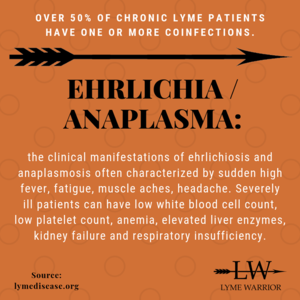Ehrlichia/Anaplasma
What is Ehrlichia?
Ehrlichia is a gram-negative bacteria that invades white blood cells, preferentially monocytes, macrophages, and neutrophils. There are three species known to cause illness in people: E. chaffeensis, E. ewingii, and E. canis, although E. chaffeensis is considered the most common species to do so. The Lone Star tick (Amblyomma americanum) is known to transmit E. chaffeensis although transmission by other tick species cannot be ruled out.
Ehrlichosis is a rickettsial-like illness and is considered a reportable disease, meaning if a doctor diagnoses someone with Ehrlichia they are expected to report it to their local and state health departments, as well as the CDC. Statisitics reported here by the CDC, show that cases of Ehrlichiosis have risen dramatically over the past twenty years. Four states (Missouri, Arkansas, North Carolina, New York) account for half of all reported cases. Ehrlichiosis has been reported in almost all fifty states.
The disease caused by Ehrlichia chaffeensis is called human monocytotropic ehrlichiosis, or HME.
What are the symptoms of Ehrlichia?
Symptoms typically develop one to two weeks after a tick bite and may include fever, chills, severe headache, generalized muscle pain and non-specific flu-like symptoms.
Other, less common symptoms of Ehrlichia include:
Rash or diffuse redness (more common in children)
Gastrointestinal (nausea, vomiting, diarrhea)
Respiratory (cough, acute respiratory distress syndrome)
Central nervous system (meningitis, seizures, coma)
Sepsis or toxic-shock-like syndrome
What is a Ehrlichia Rash?
The proportion of patients with ehrlichiosis who develop a skin rash varies between 20 to 88% of cases. When present, the rash takes various forms. It has been described as red, petechial (small red or purple spots due to bleeding into the skin), macular (flat discolourations), and papular (small lumps). Less commonly, lesions are described as blistering, nodular (larger solid lumps), vasculitic, purpuric, mottled, blotchy, crusted, or ulcerated. A single patient may display multiple types of lesions. In severe cases, a widespread rash and desquamation (shedding of the skin in scales) can fit criteria for toxic shock syndrome. The rash appears from day 0 to day 13 of the illness. The rash has a variable distribution over the body, but the palms and soles are rarely involved.
How is Ehrlichia diagnosed?
Because of the potential for severe illness, diagnosis is often made based on clinical symptoms alone, especially if there is a history of a recent tick bite. For this reason, treatment is often initiated prior to diagnostic testing. It is recommended that samples for diagnostic testing be collected prior to antibiotic therapy as antibiotic use appears to reduce the sensitivity of the tests.
Several tests can be used including PCR and IFA. A comprehensive review of testing methods as well as their limitations can be found here.
What is Anaplasma?
Anaplasma is a gram-negative, intra-cellular bacteria that invades white blood cells (typically neutrophils) and, like Ehrlichia, is also considered a rickettsial-like illness. Anaplasma phagocytophilum is the species responsible for Anaplasma infections in the United States. It is known to be transmitted by the black-legged tick (Ixodes scapularis), although the dog tick (Dermacentor variabilis) has also been implicated in transmission. Once considered to be a species of Ehrlichia, A. phagocytophilum was recently renamed based on genetic analysis.
The disease caused by A. phagocytophilum is called human granulocytic anaplasmosis, or HGA.
What are the symptoms of Anaplasma?
Symptoms of Anaplasma are similar to Ehrlichia, although they tend not to be as severe. However, rash is not a common symptom with Anaplasma, nor is central nervous system involvement.
What is an Anaplasma rash?
Skin manifestations of anaplasmosis are rare, occurring in only 1 to 16% of cases. The lesions have been described as red, flat or raised, pustular (pus-filled blister), or papular. Compared to ehrlichiosis, the lesions associated with anaplasmosis are more often individual, localised, and may represent tick-bite lesions. (Ref: https://www.dermnetnz.org/topics/ehrlichiosis-and-anaplasmosis/)
How is Anaplasma Diagnosed?
In addition to clinical history and symptoms, several testing methods can be used. A more complete overview of tests and their limitations can be found here.
Summary:
Both Anaplasma and Ehrlichia are gram-negative bacteria that invade white blood cells. They are transmitted by tick bites - Anaplasma by the black-legged tick and Ehrlichia by the Lone Star tick. While Ehrlichia tends to cause more severe illness, both can cause non-specific, flu-like symptoms within one to two weeks of a tick bite. Diagnosis is based on a combination of clinical symptoms, history, and blood testing. Both tend to respond well to treatment, especially if initiated early.
Both Anaplasma and Ehrlichia are considered reportable diseases and physicians making a diagnosis are recommended to report it to their local and state health departments, as well as the CDC.
Frequently Asked Questions about Ehrlichia and Anaplasma
What are Ehrlichia and Anaplasma?
Ehrlichia and Anaplasma are two closely related bacteria that can cause similar tick-borne illnesses in humans. Ehrlichia species primarily cause human monocytic ehrlichiosis (HME), while Anaplasma species cause human granulocytic anaplasmosis (HGA).
What are the common symptoms of Ehrlichia and Anaplasma infections?
Symptoms of Ehrlichia and Anaplasma infections can be similar and typically include:
Fever.
Headache.
Muscle aches.
Fatigue.
Chills.
Nausea.
Confusion (in severe cases). However, the severity and specific symptoms may vary among individuals.
How are Ehrlichia and Anaplasma infections diagnosed?
Diagnosis of Ehrlichia and Anaplasma infections involves a combination of clinical evaluation, medical history, and laboratory tests. These may include blood tests to detect antibodies against the bacteria or molecular tests, such as polymerase chain reaction (PCR), to identify the presence of bacterial DNA in the blood.
What is the treatment for Ehrlichia and Anaplasma infections?
The treatment of choice for Ehrlichia and Anaplasma infections is usually the antibiotic doxycycline. This medication is effective in most cases and is typically administered for a period of 7 to 14 days. In severe cases or for patients who cannot tolerate doxycycline, alternative antibiotics may be used. Always consult with a physician about what the best treatment would be based on your individual case.
How are Ehrlichia and Anaplasma infections transmitted?
Ehrlichia and Anaplasma infections are primarily transmitted through the bite of infected ticks. Different species of ticks can carry these bacteria, including the black-legged tick (Ixodes scapularis) and the lone star tick (Amblyomma americanum). Humans can become infected when bitten by an infected tick.
What are the differences between Ehrlichia and Anaplasma infections?
The main difference lies in the specific bacteria involved and the types of cells they infect within the human body. Ehrlichia infects monocytes, a type of white blood cell, while Anaplasma infects granulocytes, another type of white blood cell.
Can Ehrlichia and Anaplasma infections be prevented?
Preventing Ehrlichia and Anaplasma infections involves taking measures to prevent tick bites. These include:
Avoiding tick-infested areas, especially during peak tick season.
Wearing protective clothing, such as long sleeves and pants, when spending time in wooded or grassy areas.
Using insect repellents that contain DEET or permethrin on exposed skin and clothing.
Conducting regular tick checks on yourself, family members, and pets after outdoor activities.
Are there any complications associated with Ehrlichia and Anaplasma infections?
In some cases, Ehrlichia and Anaplasma infections can lead to severe complications, particularly if left untreated. These complications may include respiratory distress, organ failure, bleeding disorders, or neurological issues. Prompt diagnosis and treatment are crucial to prevent complications.
It's important to consult with a healthcare professional for accurate diagnosis, appropriate treatment, and guidance on tick bite prevention strategies specific to your region.

